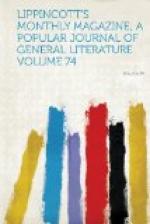Of buildings strong, albeit of paper hight,[A]
confronting with massy contrast the lighter, older, more fantastically shrouded one named of Harcourt, with the cheerful Crown Office Row (place of my kindly engendure), right opposite the stately stream which washes the garden foot with her yet scarcely trade-polluted waters and seems but just weaned from Twickenham Na?es! A man would give something to have been born in such places. What a collegiate aspect has that fine Elizabethan hall where the fountain plays which I have made to rise and fall how many times, to the astonishment of the young urchins my contemporaries, who, not being able to guess at its recondite machinery, were tempted to hail the wondrous work as magic.” Though its courts may have been “magnificent” and “ample” to the contemplation of the kindly Lamb, they would scarce be so accounted now.
[Footnote A: Paper Buildings.]
The “great Cham of Literature,” Dr. Samuel Johnson, resided for some time at No. 1, Inner Temple Lane. Indeed, it was while the doctor was living in the Temple that the world-famous “Literary Club” was founded. The faithful and receptive Boswell, too, as might be expected, lived within easy distance of the object of his veneration, at the foot of Inner Temple Lane. It was in 1763 that Boswell first made the acquaintance of the “Great Bear” and called on him in his Temple chambers.
Cowper the poet, as the reader doubtless remembers, at first embraced the law as his profession. He was duly articled to a solicitor of some eminence; but with how little ardor he devoted himself to the study may be inferred from the following candid confession: “I did actually live three years with Mr. Chapman, a solicitor,—that is to say, I slept three years in his house, but I lived, I spent my days, in Southampton Row. Here was I and the future Lord Chancellor [Thurlow] constantly employed from morning till night in giggling and making giggle instead of studying law.” It is not surprising, as one of his biographers remarks, that when, at the age of twenty-one, he proudly became the occupant of a set of chambers in the Middle Temple, “he neither sought business nor business sought him.”




